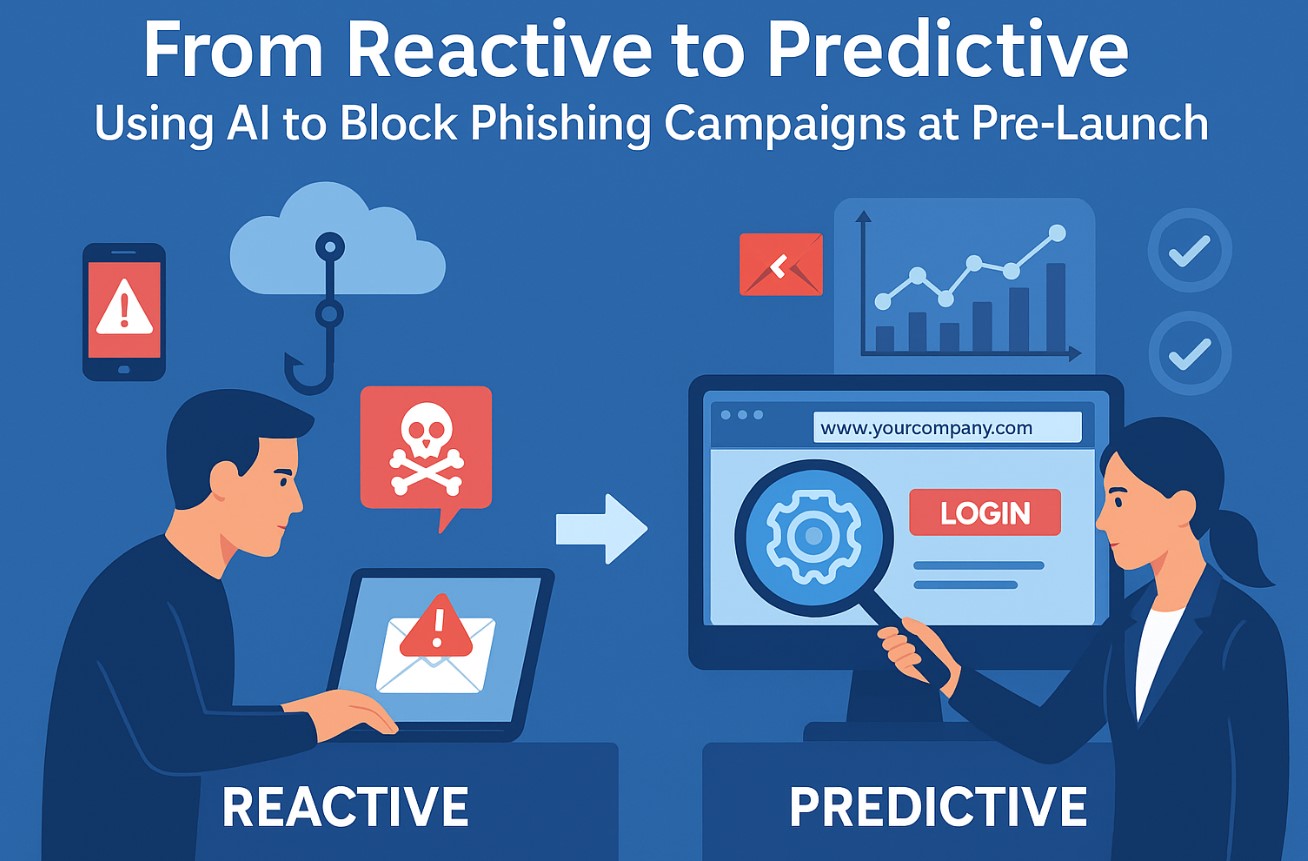
From Reactive to Predictive: Using AI to Block Phishing Campaigns at Pre-Launch

We are in an era where phishing attacks have grown both in volume and sophistication; simply reacting to threats is no longer sufficient. Traditional email security tools often play defense, relying on known signatures or blacklists to block malicious messages after they arrive. By the time these threats land in users' inboxes, the damage is already at the doorstep. Predictive phishing defense flips this script: it treats phishing like a storm brewing on the horizon, using early warning signals to prepare and stop the attack before it hits.
Predictive phishing detection involves monitoring a broad range of signals—such as unusual domain registrations, leaked credentials, and suspicious chatter on dark web forums—for clues of a future attack. Think of it as a radar system scanning the sky for ominous clouds. If a domain appears that mimics your brand, or a newly created email account is set up to look like an executive, the system raises an alert. In cybersecurity terms, this approach is often called pre-campaign threat detection or AI-driven phishing protection, because it uses intelligence and analytics to forecast threats rather than merely reacting to them.
This blog explores what proactive phishing defense really means for enterprises. We’ll look at how attackers quietly assemble the components of a phishing campaign—registering domains, setting up fake websites, and staging impersonation emails—and how each step can be detected early.
We’ll expose the blind spots in typical enterprise security that attackers exploit, such as unsupervised domain portfolios or unmonitored account changes. We’ll define the key early threat indicators, from subtle linguistic clues in an email draft to the launch of a cloned login site. You’ll also learn why catching these cues early confers a powerful strategic advantage: it saves companies from costly breaches and brand damage, turning security teams from exhausted responders into empowered forecasters.
We’ll share examples in finance, healthcare, SaaS, and education, illustrating how different industries benefit from predictive defense. Finally, we cover how to build risk models and forecasts that guide resource planning, and outline an architecture for layering predictive intelligence into platforms like Microsoft 365 or Google Workspace. By the end, you’ll have a deep, practical understanding of how to prevent phishing campaigns at the source, turning the security model from reactive to preemptive.
What Predictive Phishing Defense Means
Predictive phishing defense is a proactive approach to email security. It treats phishing like a brewing storm or an infection incubating in a community: defenses prepare long before the first drop falls. Instead of reacting to a completed attack, predictive systems constantly scan for subtle clues that an attack is being planned. These clues might come from unusual domain registrations, spikes in relevant conversations on forums, leaks of employee credentials, or even new email accounts set up by suspicious actors.
In practical terms, predictive defense combines external and internal intelligence to spot anomalies outside the corporate perimeter. For example, it might identify that dozens of domains resembling your company’s name were just registered, or detect that a draft email with an urgent tone is circulating on an underground forum. Using a combination of machine learning and rule-based techniques, the system correlates these fragmented signals into coherent warnings. Over time, it learns the writing styles of company executives and the normal cadence of internal communications, so that even a small deviation (like a CEO using an unusual greeting) can raise an alert.
Key characteristics of predictive phishing defense include:
- Wide-Angle Threat Monitoring: Continuously watching domain registration sites, certificate logs, and threat intelligence sources. This allows detection of fake domains (e.g. yourcompany-login.com) and cloned sites (with your logo and forms) as soon as they appear.
- Behavioral and Contextual Analysis: Tracking normal communication patterns and baselines. For instance, flag a CIO email requesting an urgent transfer if the CIO never sends such requests or is known to be on vacation. By understanding what “normal” looks like, the system spots what’s not normal.
- Accelerated Alerting: Generating automated alerts on these clues so security teams have time to respond. An alert might trigger blocking a suspicious domain or pre-emptively quarantining an email server, effectively interrupting the attack chain before it starts.
- Adaptive Intelligence: Continuously refining what signals matter. The more threats your system intercepts, the more it learns which linguistic cues, sending patterns, or infrastructure changes truly indicate a malicious campaign. Over time, it becomes better at filtering noise from real danger.
- Integrated Forecasting: Treating phishing risk as an ongoing forecast. Regularly update your risk dashboards and security playbooks using the predictions. If the system predicts a wave of CEO fraud attempts next month, that becomes actionable intel—security training schedules, email policy adjustments, and IT checks are put in place proactively.
Together, these capabilities turn security teams into forecasters rather than firefighters. Predictive defense doesn’t eliminate traditional measures; instead, it adds an anticipatory shield on top of existing email filters, making the entire security posture richer and more resilient.
How Attackers Build Phishing Infrastructure (Pre-Delivery Detection)
A phishing campaign begins long before any inboxes are hit. Attackers methodically assemble their phishing “arsenal” step by step. First, they register deceptive domains – often using slight misspellings (typosquatting), added keywords (like “secure-” or “-login”), or new top-level domains. For example, phishers might create yourbank-online.com or a website with your logo on yourbank.secure-login.co. They set up DNS records and obtain SSL certificates so the fake site looks trustworthy (often monitoring Certificate Transparency logs to do this stealthily). In parallel, they design the fake website itself, cloning corporate login pages and embedding hidden fields to harvest credentials.
Next, they deploy the content. Using either custom code or off-the-shelf phishing kits, attackers replicate official login or portal sites. These kits often come with telltale markers (like certain image names or URL paths) that defenders can spot. The fake site is hosted (sometimes on bulletproof web hosts that ignore abuse requests) and pointed at the registered domain. Meanwhile, the email side is prepped: attackers configure SMTP servers (rented or compromised), create email addresses resembling internal or vendor domains, and set up infrastructure to track who clicks links or enters credentials. Often, they conduct small-scale tests – sending a few emails to honeypot accounts or trying logins on different devices – to verify their kit works and evade filters. Each of these steps leaves potential traces in logs and threat feeds.
Key elements in the phishing infrastructure include:
- Deceptive Domains: The domain is the anchor of an attack. Attackers target any brand names, abbreviations, or trademarks related to you. Security teams should log all domains with company keywords or product names, then flag anything new or odd. For instance, if an attacker registers dozens of domains and obtains certificates containing your logo, that’s a strong red flag.
- SSL and Hosting: Modern phishers use valid SSL certificates so the fake site appears authentic (even showing a padlock). Monitoring Certificate Transparency logs can catch certificates issued to strange domain names. Similarly, checking where potential phishing domains are hosted (cloud or VPS providers) helps spot if they appear on suspicious servers.
- Cloned Website Content: The actual web pages often contain telltale signs. Automated scanners can crawl the web looking for pages that match your company’s login HTML or logos. Finding a nearly identical page on a random domain is a smoking gun. Some defenders use image recognition (searching for your logo) or text comparison tools to find these clones early.
- Email Sending Infrastructure: Attackers need a way to deliver their bait. This might be a compromised mail server inside your network, rented SMTP servers, or bulk-mail platforms. Unusual spikes in outgoing email traffic, new mail servers appearing in logs, or high volumes of emails from a single IP can all betray this setup stage.
- Testing and Staging Activity: Before full launch, attackers often test their kit. They might send a handful of emails to see if they pass spam filters or try a few login attempts on the phishing site. Look for anomalies like mass login failures, password reset attempts on test accounts, or small bursts of outbound mail from a new domain – these are footprints in the sand. For example, if your email gateway suddenly sees dozens of messages from a fresh domain that just got registered, it’s worth investigating.
By focusing on these pre-delivery steps, defenders can disrupt phishing campaigns at their source. If you take down the domain or server an attacker is building on, the fraud collapses. Think of it as defusing a bomb by removing the fuse before it ignites. Each part of the infrastructure (domain, certificate, site, server, etc.) is a piece of evidence. Detecting and removing just one piece can render the entire phishing campaign useless.
Enterprise Blind Spots Under Siege
Even a castle with strong walls can fail if an invader finds an unlocked gate. In cybersecurity, blind spots are those hidden doors that phishers love to exploit. Here are some common examples:
- Untracked Digital Assets: Many organizations have sprawling online footprints – extra domains, forgotten services, or branding for subsidiaries and events. An attacker will use anything not closely watched. For example, a little-used corporate website or an old marketing portal might not be scanned regularly. If your security team isn’t continuously cataloging all domains and external assets, a new phishing site can hide in the shadows of “forgotten” infrastructure.
- Third-Party and Supply Chain Trust: We often trust emails from known partners or vendors. Phishers exploit this by spoofing third-party addresses (or even compromising them). Many systems allowlist partner domains or email addresses, so a cleverly spoofed vendor message can sail through. Imagine giving a key to your office to a long-time contractor without verifying who shows up – that’s the risk here.
- Employee Human Factors: People are unpredictable. Busy employees or new hires may not notice subtle anomalies. Phishers time their attacks for maximum impact – like sending impersonation emails during major deadlines, company events, or crises (when panic is high). If employees aren’t trained on the latest deception techniques (e.g. deepfake calls, social media impersonation), they can be easily manipulated. Relying solely on user vigilance without technological support creates a blind spot.
- Outsourced and Shadow IT: Any service not under central IT oversight is a risk. This includes personal email accounts, unsanctioned cloud apps, or niche platforms. Attackers may deliver phishing via these channels, knowing they bypass main filters. For instance, a one-off Slack workspace or personal email chain could carry a malicious link. If your policies don’t monitor or restrict these channels, attackers have hidden tunnels into the organization.
- Static Perimeter Defenses: Many enterprises focus on hardened perimeters (firewalls, email gateways, secure web proxies) but neglect continuous monitoring. For example, attackers might host a phishing site on a trusted cloud domain (like a public blog or storage service) that isn’t blacklisted. In this case, an otherwise “secure” domain is used for evil. In short, defenses that only rely on fixed blacklists or IP blocks can miss novel threats at the edge.
- Delayed Intelligence Updates: If your security systems update only after a threat is reported, there’s a dangerous time lag – a blind spot. Real-time intelligence sharing (for instance, subscribing to feeds of newly seen phishing sites) helps close this gap. Without it, the window between “attacker registers exploit” and “defender blocks it” can be wide open.
- BYOD and Remote Devices: Many organizations allow email on personal devices or home networks, which can escape normal monitoring. Attackers exploit these gaps by targeting employees’ smartphones or VPN logins. If your predictive system only watches corporate mailboxes or networks, it might miss a fake email opened on a home device. Ensuring remote and mobile accounts are visible to predictive scans is therefore a best practice.
- Over-Trusting Automation: It’s easy to assume automated filters catch everything, but even the smartest algorithms need tuning. For example, if a company’s safe-sender list is too permissive, or if employees habitually mark unknown emails as “safe,” attackers can slip through. Regularly reviewing and tightening automated rules prevents complacency from becoming a blind spot.
By addressing these blind spots, organizations ensure no nook or cranny is ignored. The goal is to make sure that any sign of pre-attack activity, no matter how small, triggers scrutiny rather than slipping under the radar. In essence, blind spots are like unlocked side doors – even the best walls fail if those aren’t watched. Filling these gaps is essential for comprehensive phishing attack prevention, leaving fewer places for attackers to hide.
Early Threat Indicators: Listening to the Noise
Before a phishing campaign goes live, it often leaves a trail of subtle clues. Think of defenders as detectives noticing hints that a crime is being plotted. Effective predictive defenses listen for these early warning signals:
Linguistic Shifts
Draft phishing messages or posted content might exhibit unusual language. Attackers often scrape corporate memos or social media to mimic writing style, but small differences remain. For example, a phishing draft might address customers as “Dear Valued Customer” instead of your company’s customary greeting, or use oddly formal phrasing that an executive wouldn’t.
Advanced systems use semantic analysis and stylometry (writing-style fingerprinting) to catch these mismatches – essentially detecting that “the author isn’t who you think.” These techniques flag messages that “sound off,” even if they superficially look correct.
Impersonation Staging
Phishers set the stage to appear legitimate. This might include creating fake social media profiles of executives, registering lookalike email addresses (like ceo@y0urcompany.com with a zero), or even setting up dummy LinkedIn pages. Monitoring for any new accounts or profiles using your brand or staff names can reveal these setups.
A spike in related internal activity (such as suddenly granting a generic account unusual permissions) can also be a sign, indicating an attacker is establishing footholds. Detecting one fake profile early can break the illusion an attacker needs.
Clone Portals
One of the most tangible indicators is a newly published fake login site. Attackers replicate an official login portal on a lookalike domain, complete with your branding and form fields. Security teams can detect these by using automated tools: web crawlers search for identical webpage content or form structures, and monitor Certificate Transparency logs to see if a new SSL cert has been issued to a suspicious domain. If you suddenly find your company’s login page on an unknown domain, that’s a red flag. It’s like finding your own office’s lock on a street building that’s not yours.
Technical Signals
Various technical anomalies often accompany campaign staging. Unusual DNS activity – like bursts of queries for new domains related to your brand – can indicate reconnaissance or site verification. A cluster of failed login attempts on dummy accounts or mass password-reset requests is another telltale sign.
Attackers sometimes test phishing kits by sending emails to a small set of addresses; a few unexpected outbound messages from a new sender can be a tip-off. Even unexplained scans of your corporate IP range or unexpected SMTP traffic to new domains should raise eyebrows. Each of these signals, on its own, might seem harmless, but together they form the pattern of a campaign before it has even been sent.
The Strategic Advantage of Early Alerts
Catching phishing campaigns in the planning stage transforms security strategy from firefighting to forecasting. Early alerts deliver significant benefits:
Preventing Breaches
By dismantling an attack before it strikes, you stop credential theft and malware installation before they begin. An attack averted is a breach avoided. For example, if a fake CEO email is intercepted pre-launch, no one ever gets fooled and no funds are transferred. In effect, you save on every front (investigation, remediation, legal costs) because the incident never materializes. It’s the ultimate insurance policy – the best breach is one that never happens.
Lower Remediation Costs
Responding to a successful phish is expensive. It involves incident response teams, forensic investigations, customer notifications, and possible regulatory fines. Early detection means these costs are never incurred. Security leaders often find that the investment in predictive tools pays for itself by eliminating even a single major breach. This is like spending a few hundred dollars on a fire extinguisher instead of paying tens of thousands to replace a burned-down server room.
Preserving Reputation and Trust
Customers, partners, and employees trust you to protect information. A breach in which scammers impersonate your brand can erode that trust overnight. With predictive alerts, fraudulent campaigns can be stopped so quietly that end-users never even know they were targeted. When stakeholders never see the fake emails, your brand’s reputation remains intact. In one case, a healthcare network prevented a patient portal phishing entirely – patients never received fraudulent emails, and the hospital’s good name remained unblemished.
Operational Efficiency
Security teams benefit greatly. Without predictive alerts, analysts are often overwhelmed by the aftermath of attacks – chasing leads, resetting accounts, and patching holes. With early alerts, much of that goes away. Teams can focus on high-value tasks and improvements.
For example, an automated warning (“New suspicious domain registered: acme-payroll-secure.com”) can be fed into security workflows. Analysts verify and block that domain immediately, rather than spending hours investigating a completed breach. This shift reduces alert fatigue and streamlines operations.
Intelligence-Gathering Opportunities
Every intercepted campaign, even if never executed, yields intelligence. You gain samples of the attacker’s methods (emails, websites, code), which can be used to tighten future defenses. Over time, these preempted campaigns become a rich dataset. Security teams use this data to refine detection algorithms and to train employees on the latest tactics – essentially turning each near-miss into a learning opportunity.
Deterrence and Adversary Fatigue
When attackers repeatedly see their plans foiled at an early stage, they must work harder and choose other targets. Over time, knowing a target is hard to deceive can discourage some adversaries. In effect, predictive defense forces attackers into a higher effort-to-reward ratio, which can reduce the frequency of attacks. It’s like an enemy taking more time to build weapons when you’ve already knocked down their factories – eventually they may move on to easier victims.
In short, early alerts give defenders the initiative. Like intercepting a missile in its launch phase, pre-campaign suppression means attackers waste resources and time rebuilding their plans while your organization stays unscathed. This proactive posture provides a sustainable strategic edge in the ongoing arms race against cyber threats.
Use Case Examples: Finance, Healthcare, SaaS, Education
Finance
Financial institutions handle large transactions, making them lucrative phish targets. In banking, a common scam is CEO fraud (impersonating executives to authorize transfers). Predictive defense might catch this when attackers register a domain like bankname-payments.com or publish a fake wire-transfer portal. For instance, a global bank noticed several new domain registrations including its stock ticker symbol and the word “Wire.” The security team immediately blocked those domains.
No phishing emails ever reached customers, averting what could have been a multimillion-dollar fraud. In another example, an insurer detected a cloned policy portal site via domain monitoring and took it down. The scam never got off the ground, saving that company from a breach of sensitive customer data.
Healthcare
Hospitals, clinics, and insurers hold sensitive patient data, making them prime targets. Imagine attackers cloning a patient portal or health insurance login site. A predictive system might catch the registration of hospitalportal-login.com or the creation of a fake lab results page on a phisher’s website. In one case, a hospital’s security team was alerted to a lookalike domain for its electronic health record system and disabled it within hours.
No patients or staff ever clicked on the fraudulent link, and patient privacy was preserved. Similarly, predictive alerts can guard against credential harvesting schemes that target medical staff – stopping them before any PHI (Protected Health Information) can be leaked or ransomware deployed. Hospitals use this early intelligence to satisfy regulators that proactive measures were taken to protect patient data.
SaaS
Software and cloud service providers manage high-value accounts and data across many customers. Attackers may target a SaaS vendor to reach multiple organizations. For instance, a company might notice attackers registering domains combining its product name with terms like “login” or “support.” Predictive models flag these as potential phishing sites, and the domains are shut down so no user credentials are ever compromised.
Another scenario: the predictive engine detects a surge of password-reset requests across multiple client accounts, hinting at credential stuffing in preparation for phishing. Because this signal was caught early, the vendor was able to tighten login controls and alert customers. In practice, these measures keep the cloud environment secure and prevent breaches that could cascade through a multi-tenant architecture.
Education
Universities and schools often see phishing around admissions, financial aid, and research collaboration. Students and alumni may receive fake scholarship offers or donation requests. Predictive detection watches for lookalike domains of student portals or email login pages. For example, if the system flags several new domains imitating the university’s login page, IT can warn students and shut down those sites immediately. Similarly, if a fake email template for financial aid appears on cybercrime forums, advisors can proactively notify applicants. One university implemented predictive filtering and caught multiple clones of its alumni portal site before any messages were sent. By stopping scams that impersonate professors or administrators, schools protect student information, grant funds, and institutional reputation.
Risk Modeling and Operational Forecasting
Moving beyond individual alerts, many enterprises model phishing as an organizational risk and plan accordingly. Enterprise phishing risk modeling means quantifying the threat at a high level. Teams analyze historical phishing data (frequency, targets, outcomes) and current threat intelligence to simulate attack scenarios. For example, if past data shows that 80% of successful email scams targeted finance staff in late December, the model might predict a high likelihood of CEO fraud attacks during the year-end close. This quantified risk score is then used to allocate defensive measures proactively.
Email security forecasting treats phishing trends like a time series. If analytics show invoice scams spike every April (during tax season), the security team forecasts a surge in that period and prepares controls early. Forecasting steps might include running targeted phishing drills for staff, tightening email filters ahead of time, or temporarily scaling up monitoring. One organization even maintains a “phishing playbook” calendar: each quarter’s forecast drives specific training exercises, policy updates, and resource planning. This is akin to weather forecasting for cyber threats – you can “batten down the hatches” before the storm.
These models feed into operational planning. When a forecast signals an upcoming attack wave, leaders pre-position resources accordingly – adding email scanning capacity, enlisting extra analysts, or launching urgent awareness campaigns. They also track key metrics (predicted incident count, user click-through rates, and response times) against reality to refine their forecasts. Over time, this iterative process turns uncertainty into strategic insight. Leadership can essentially use these insights like financial projections – adjusting budgets and staffing based on projected cyber risk. In practice, treating phishing as a quantified risk helps justify investments: if a model predicts a 50% higher load, requesting additional security funding in that quarter becomes a data-driven argument rather than a guess.
Furthermore, enterprises tie these forecasts to key performance indicators. By treating phishing like any quantified risk, CISOs can align security spending with business priorities. For example, if a forecast predicts a 50% higher phishing volume in Q3, leadership might allocate extra budget for advanced email filtering and staff training during that quarter. This ensures security planning stays in sync with business cycles.
In practice, organizations often visualize these forecasts on dashboards. They display expected phishing attempts, actual blocked attempts, and user-reported incidents over time. Continuous feedback lets security teams compare predictions with outcomes and refine their models. Over months, analysts adjust parameters (such as expected click rates or common attack vectors) based on observed results. Essentially, this approach brings scientific rigor to anticipating threats – much like financial planners use economic forecasts to budget for market changes.
Layering Predictive Intelligence into Microsoft 365 and Google Workspace
Adding predictive phishing protection means integrating an intelligent layer into your existing email platform. Think of it as adding a new sensor to your security system. The predictive engine must collect data, analyze it for threats, and then feed its findings back into the platform’s defenses. Key architectural components include:
Data Collection
Gather relevant data from M365 or Workspace. In Microsoft 365, this might involve extracting email headers, logs, and user-reported phishing tickets through the Microsoft Graph Security API or Office 365 Management Activity API. In Google Workspace, use the Gmail API, Admin SDK, or audit logs to pull similar information. The engine can also ingest external intelligence feeds: for example, newly registered domains containing your brand name, certificate transparency logs, or known phishing signatures.
Analytics Core
This is the processing “brain” where predictive algorithms run. It could be a cloud-based service, an on-premises cluster, or an instance within a SIEM (like Azure Sentinel or Splunk). Machine learning models and rule engines examine all ingested data in real time (or near real time). For instance, the engine might apply natural language processing to incoming email content, check for abnormal sending patterns, or correlate a suspicious domain registration with email activity. The core continuously learns from outcomes, improving detection over time. It’s designed for scalability and speed so that no warning signs are missed.
Integration and Enforcement
When a threat is identified, the system must act on it. This involves connecting back to the email platform to enforce blocks or alerts. For example, the engine can call Exchange Online Protection (EOP) APIs or use PowerShell to add a flagged domain to the M365 blocklist. In Google Workspace, it could use the Gmail API or Admin tools to create a content compliance rule that quarantines any email from that domain. Automation is key – for instance, using PowerShell scripts for M365 or Google Apps Script for Gmail to update blocklists or filter rules programmatically. This way, an identified threat immediately triggers protective measures in the native security controls.
Alerts and Workflow
The architecture should include notification channels and playbooks. If the predictive system detects a campaign signal, it can send alerts to security teams via email, SMS, or collaboration tools like Teams/Slack. These alerts feed into incident response workflows or SOAR (Security Orchestration, Automation, and Response) tools, guiding analysts on how to respond – for example, to verify a domain or update a firewall rule. Prioritization (risk scoring) can help analysts focus on the most critical alerts first.
Continuous Learning Loop
Finally, integrate human feedback. When analysts verify (or dismiss) a predicted threat, that outcome is fed back into the predictive models. Dashboards and reporting help review false positives, allowing the system to adapt to your organization’s context. Over time, this feedback loop makes the predictive layer more accurate and fine-tuned.
What does it Mean?
Layering predictive intelligence on top of M365 or Workspace, organizations essentially gain an advanced early-warning radar for email threats. It complements the native filters: if the predictive layer spots something suspicious, it immediately informs the platform’s defenses. Even if a novel phishing trick evades one control, another is ready to catch it. In effect, your email ecosystem gets an extra brain tuned specifically for catching phishing before it launches – a multi-layered defense where data ingestion, analysis, integration, and feedback work together to protect users.
Building a Predictive Phishing Defense Program
Deploying predictive phishing detection is an iterative process. Here is a high-level roadmap that enterprises often follow:
- Asset Discovery: Start by inventorying all digital assets: corporate domains, subdomains, cloud apps, certificates, and email servers. Knowing your footprint is crucial so that no new or shadow asset slips by unnoticed. Automated discovery tools can help maintain this list. This inventory becomes the baseline for monitoring – the known “ground” against which anomalies stand out.
- Threat Feed Integration: Connect to external data sources. Subscribe to domain registration feeds, certificate transparency logs, dark web paste sites, and phishing intel services. These feeds provide raw signals (e.g. new domain registrations containing your brand, leaked credentials, or phishing templates) that the predictive system will analyze. Also ingest internal data: email flow logs, authentication logs, and user-reported incidents. The richer the data, the earlier a pattern can emerge.
- Analytics Development: Build or deploy the analytics engine. Use machine learning models or rule-based logic to correlate the signals. Begin with known indicators (like brand names in domain registrations) and then incorporate more complex features (anomaly detection on email volume, linguistic analysis on text). Validate the model using historical phishing cases or red-team exercises to ensure it can recognize real threats without too many false positives. It’s important to tune sensitivity over time: initial models may err on the side of more alerts, but refinements will improve precision.
- Platform Integration: Enable the enforcement mechanisms. Work with your email and security admins to allow automated or semi-automated actions. For Microsoft 365, this might mean granting permission for the predictive system to update Exchange transport rules; for Google Workspace, APIs to manage Gmail compliance rules. Also integrate with your SIEM or SOC tools so that predictive alerts become part of standard incident workflows. Early on, the system might run in “alert-only” mode (informing analysts) before shifting to active blocking once confidence grows.
- Testing and Tuning: Before fully relying on it, test the system with controlled scenarios. For example, spin up a test phishing domain or send simulated phish emails to see if the system flags them. Adjust thresholds to balance sensitivity and noise. Regularly perform red-team exercises that mimic real attackers (e.g. targeted spear-phish), then use the results to improve the models. Continuous tuning is essential, as attackers will adapt their tactics over time.
- Operation and Governance: Establish how alerts will be handled day-to-day. Define incident response playbooks specific to pre-campaign alerts (e.g. procedures for domain takedown, legal notifications, or policy changes). Train your SOC analysts and IT staff on these processes. Regularly review false positives to adjust models. Document the program – including roles, responsibilities, and escalation paths. Over time, refine policies as the threat landscape evolves, ensuring predictive defense remains tightly integrated into your overall security program.
By following these steps, an organization builds a mature predictive defense capability. The key is iteration: with each thwarted attempt, the system learns and improves. As one security leader put it, “Each foiled phish becomes another drill we ran, another lesson learned.” Eventually, predictive phishing detection can run as smoothly as antivirus updates or patch management – quietly and continuously protecting before the first phishing email is ever read by a user.
Looking Ahead: The Future of Phishing Defense
Predictive phishing detection is rapidly becoming a key part of enterprise cybersecurity strategy. As attackers gain access to more automation and AI tools, defenders must keep pace. In the future, we expect predictive intelligence to extend beyond email. For example, similar models can be applied to SMS and chat platforms (smartphone phishing, known as “smishing”), or even to identify early signals of voice phishing (“vishing”) campaigns. The core idea remains: spot and disrupt the attacker’s playbook as soon as possible.
Another future trend is deeper integration with identity and access management. Predictive signals could feed into conditional access decisions: if a new phishing domain targeting executives is detected, the system might automatically require additional authentication for those accounts or temporarily tighten login rules. Conversely, anomalous login attempts (like accessing cloud apps from unusual locations) could feed back into the phishing model.
Automation and orchestration tools will also mature. We may see systems that not only alert but autonomously respond – for instance, automatically adding a suspicious email domain to DNS blocklists or isolating a dubious email server. This level of automated intervention requires high confidence, but as predictive models improve, we anticipate tighter feedback loops between detection and response. In practice, mature organizations might deploy automated playbooks that update firewalls or email filters within seconds of a threat detection, effectively giving the SOC a “fast-forward” button.
Global collaboration will play a role. As threat intelligence becomes more real-time, enterprises may share pre-campaign indicators through industry ISACs or security communities. Picture a future phishing honeypot network: automated sensors feed data into a collective brain, which then warns member organizations of emerging phishing trends. By treating pre-campaign intelligence as a shared resource, companies can raise the bar for attackers. For example, if one bank detects a novel CEO fraud tactic, sharing that insight could help other banks lock down similar attacks before they start.
One exciting possibility is the use of AI-driven simulations. Security teams may leverage generative AI to mimic attacker behavior, allowing them to proactively hunt for predictive signals. Conversely, machine learning itself will improve: models will continually refine using global phishing data lakes. This means even novel tactics (like deepfake phishing or multi-step impersonations) can be anticipated if the underlying patterns are spotted early enough.
Basically, phishing prevention will evolve from a static checklist to a dynamic, intelligence-driven discipline. Organizations that build robust predictive capabilities today will be at the forefront of this shift. By investing in early-warning systems and pattern intelligence, defenders can turn the tables on attackers – making each phishing campaign significantly harder to launch and far less effective if it does start. The future of phishing defense lies in anticipation and adaptation, and the most secure enterprises will be the ones stopping attacks at inception, forcing adversaries to operate on the defenders’ timeline.
Frequently Asked Questions (FAQs)
Q1: What is predictive phishing detection and how is it different from traditional email security?
Predictive phishing detection is proactive: it identifies early signs of a campaign in advance, rather than waiting for malicious emails to arrive. It monitors precursor signals (like suspicious domain registrations or unusual message patterns) to forecast and block attacks. In other words, it’s like a security radar that spots and stops the threat on the horizon. For example, while a spam filter needs to see a phishing email, a predictive system might alert on the fake domain before a single malicious message is sent.
Q2: How does pre-campaign threat detection stop phishing attacks before they happen?
It scans for preparations and halts them. For instance, if a new domain mimicking your payroll system appears on a monitoring feed, pre-campaign detection will flag it immediately. Security teams can then block that domain or take down the fake site, so no phishing email ever goes out. This is like defusing a bomb by removing its components before it’s triggered – the attack infrastructure is neutralized at the source, and users never receive the fraudulent message.
Q3: What are some early warning signs of an impending phishing campaign?
There are clues in both language and infrastructure. Linguistic anomalies – such as odd phrasing or an unusual tone in an email draft – can hint that a phishing template is being crafted. Impersonation staging is another signal: fake executive profiles, newly created email addresses using staff names (e.g. john.doe@companies-svc.com), or cloned vendor sites.
Technical indicators matter as well: lookalike domains or cloned login pages appearing online, surges in related DNS queries or certificate registrations, and clusters of failed login or password-reset attempts can all signal that attackers are preparing an operation. Each of these clues by itself might seem benign, but together they paint the picture of an attack before it launches.
Q4: How can enterprises use risk modeling and forecasting to improve phishing prevention?
Phishing risk modeling quantifies the threat and shapes strategy. Organizations analyze past incidents and current intel to simulate attack scenarios and predict outcomes. For example, if data shows invoice scams spike in Q2, defenders might forecast higher phishing volume then and prepare extra controls in Q1. This is essentially email security forecasting: treating cyber threats like a business metric.
Leadership can tie these forecasts to budgets and KPIs – allocating resources proactively. In practice, a security team might plan drills and extra email filtering if the model predicts a wave of CEO fraud. By turning trends into numbers, phishing defense becomes an integrated part of enterprise risk management, guiding decisions rather than relying on guesses.
Q5: How do organizations integrate predictive phishing protection into Microsoft 365 or Google Workspace?
They connect the predictive analytics engine to the platform’s APIs and security controls. In Microsoft 365, for example, the system might use the Graph Security API or Exchange cmdlets to ingest email logs and then update policies (like adding a malicious domain to the blocklist) automatically. In Google Workspace, the engine could use the Gmail API or Admin SDK to scan mail flow and adjust filters or DLP rules.
Once the predictive layer flags a threat, it instantly programs the native filters or quarantines to stop it. For smaller teams, even partially automating this (such as a daily report of suspicious domains for manual review) is a good start. Over time, integration can evolve to fully automated workflows within the platform.
Q6: What role does AI play in modern phishing defense?
AI and machine learning significantly boost phishing protection. They analyze large volumes of email content, metadata, and user behavior to spot complex patterns (like a subtle change in writing style or correlated signals across channels) that humans or simple rules might miss. AI-driven models can identify anomalies and learn from new threats, making them effective at detecting novel phishing tactics.
In practice, AI adds muscle to your security team – automating anomaly detection and prioritizing threats. AI-driven phishing protection provides faster, smarter insights.









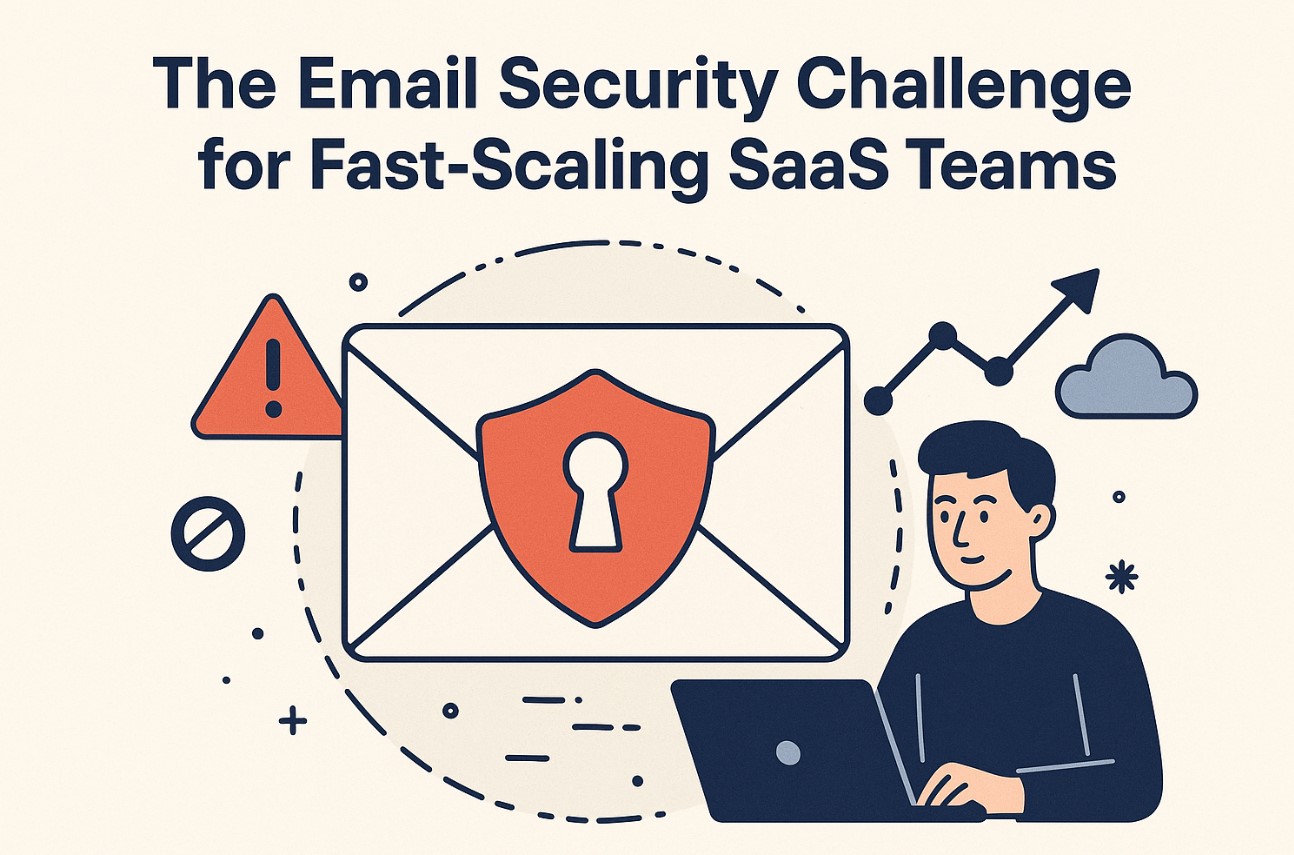
.png)


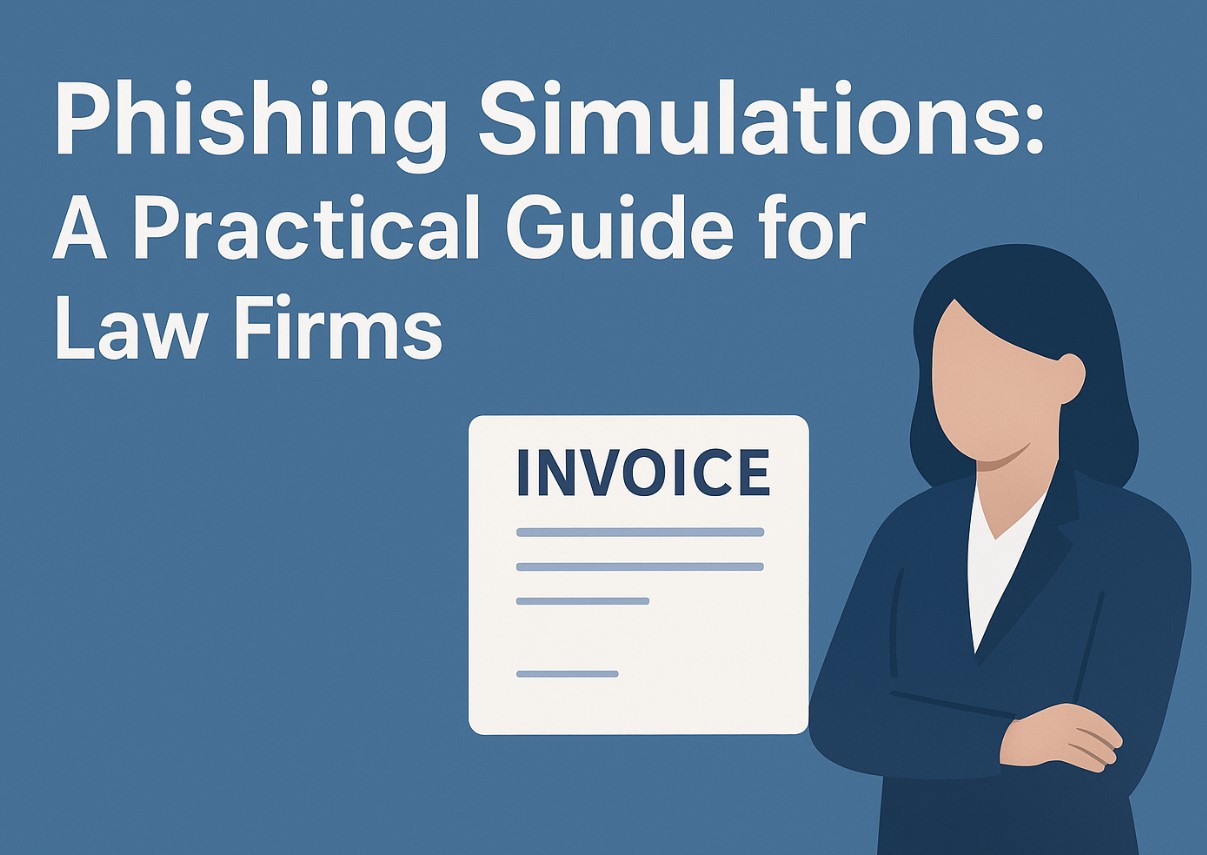


.png)
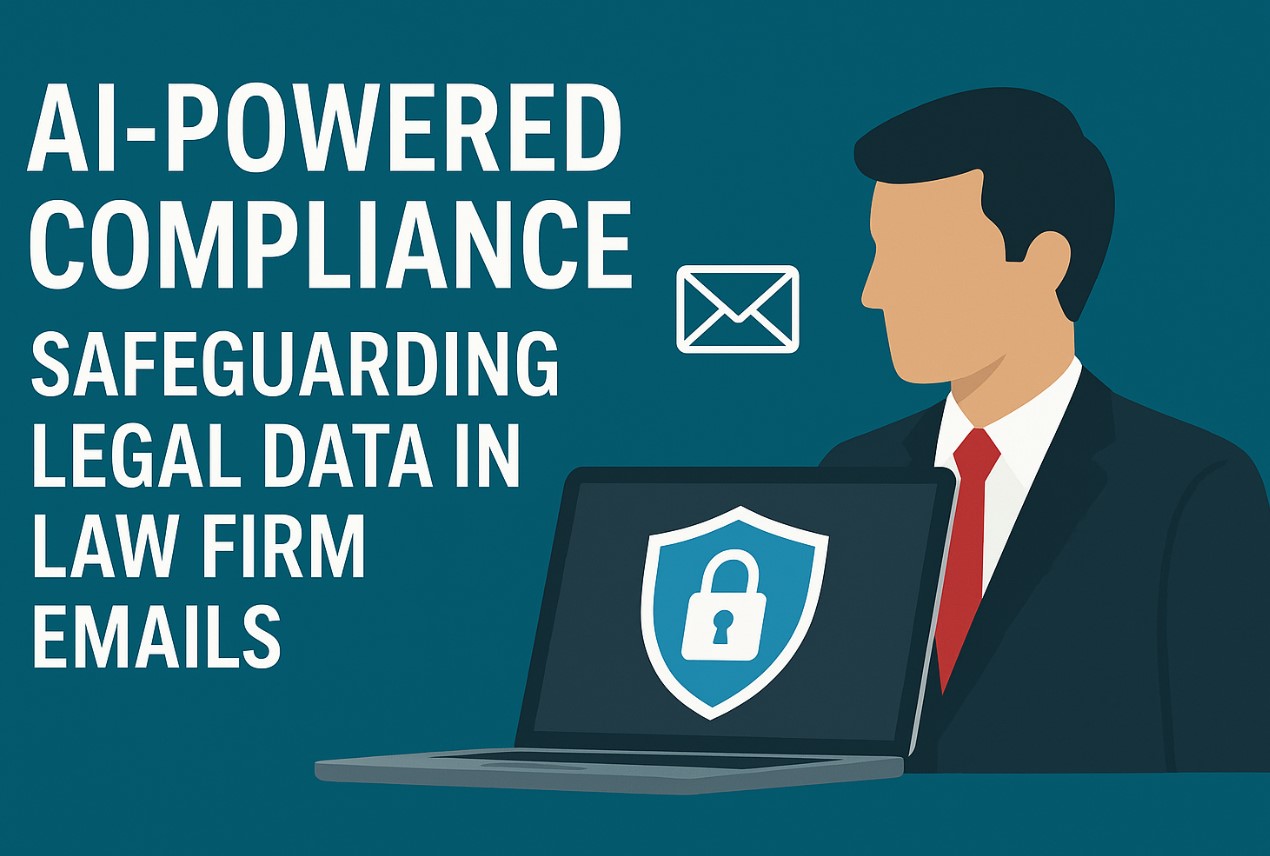

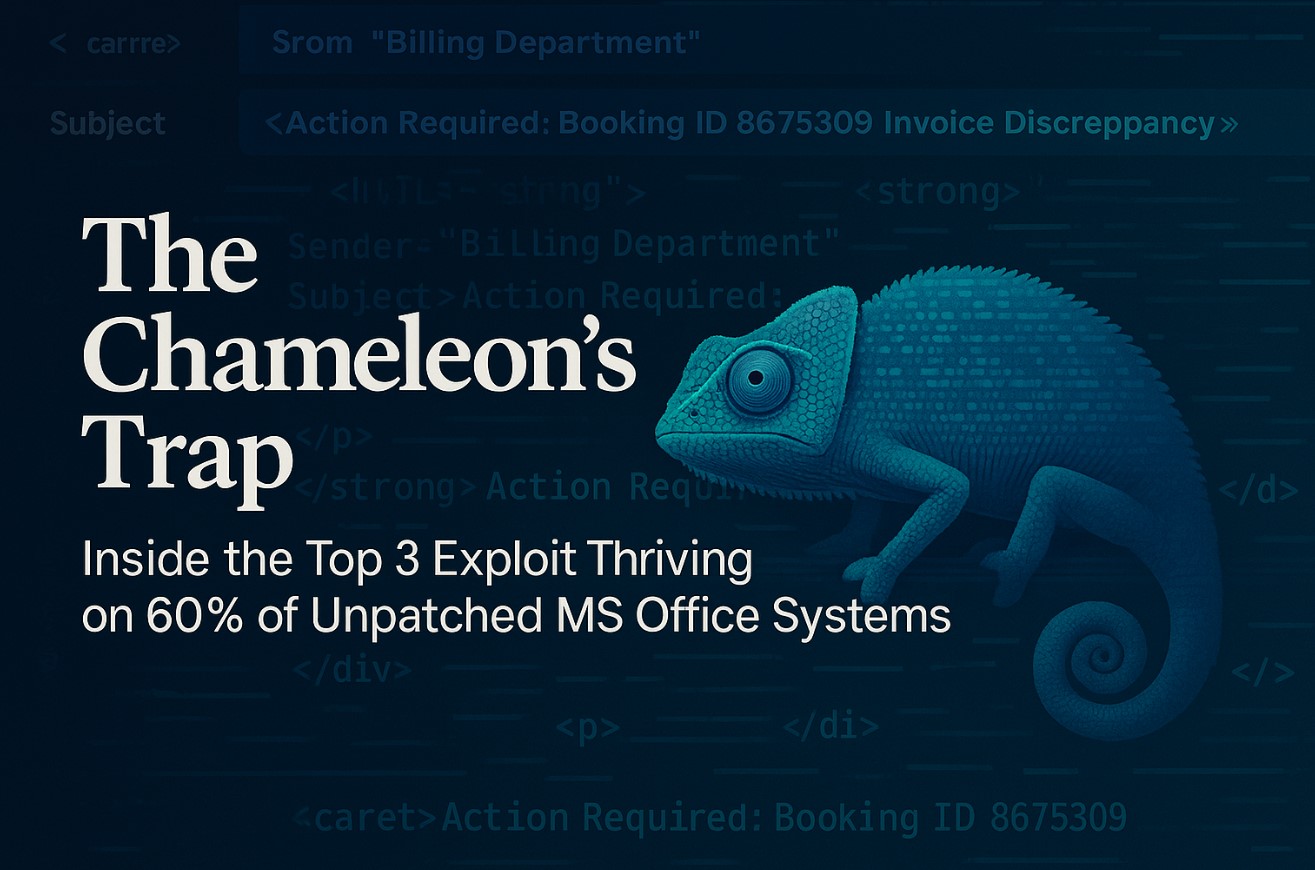

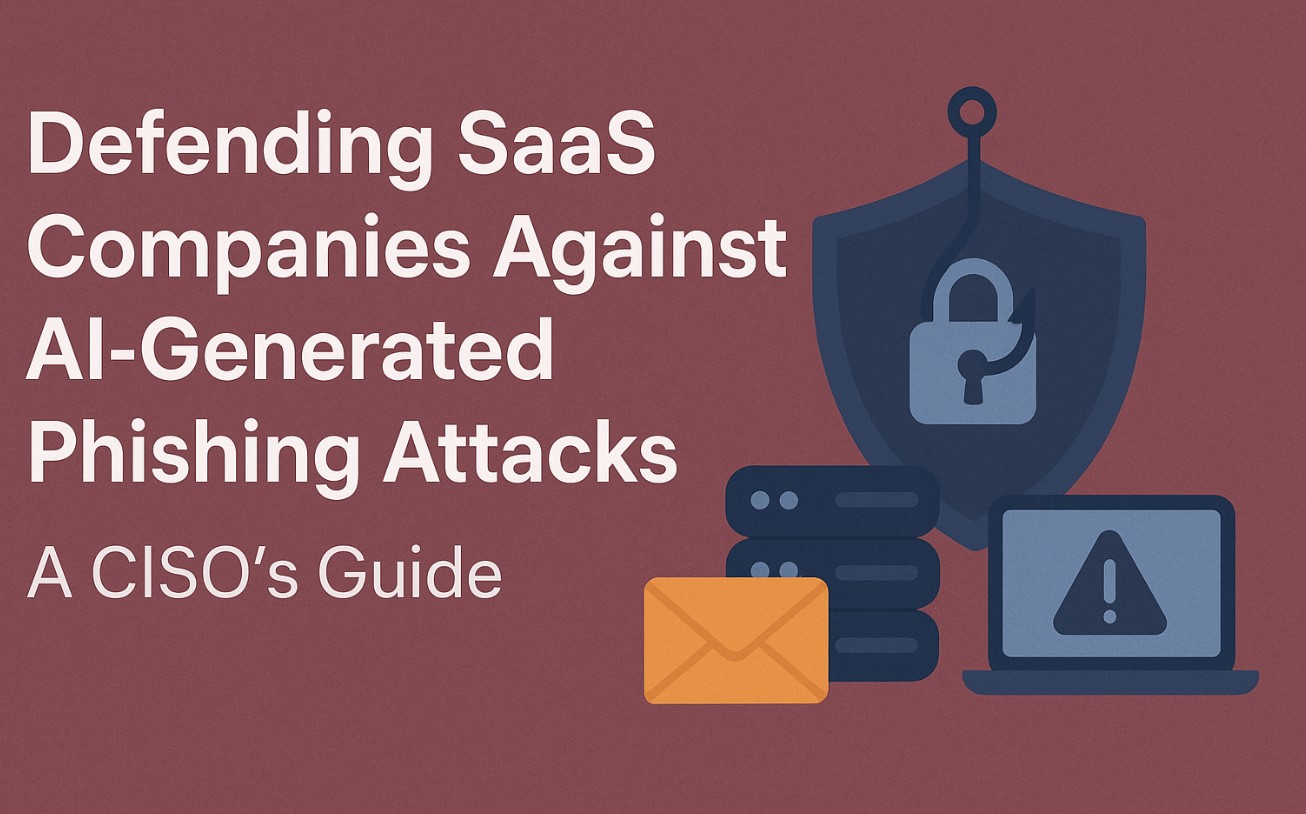


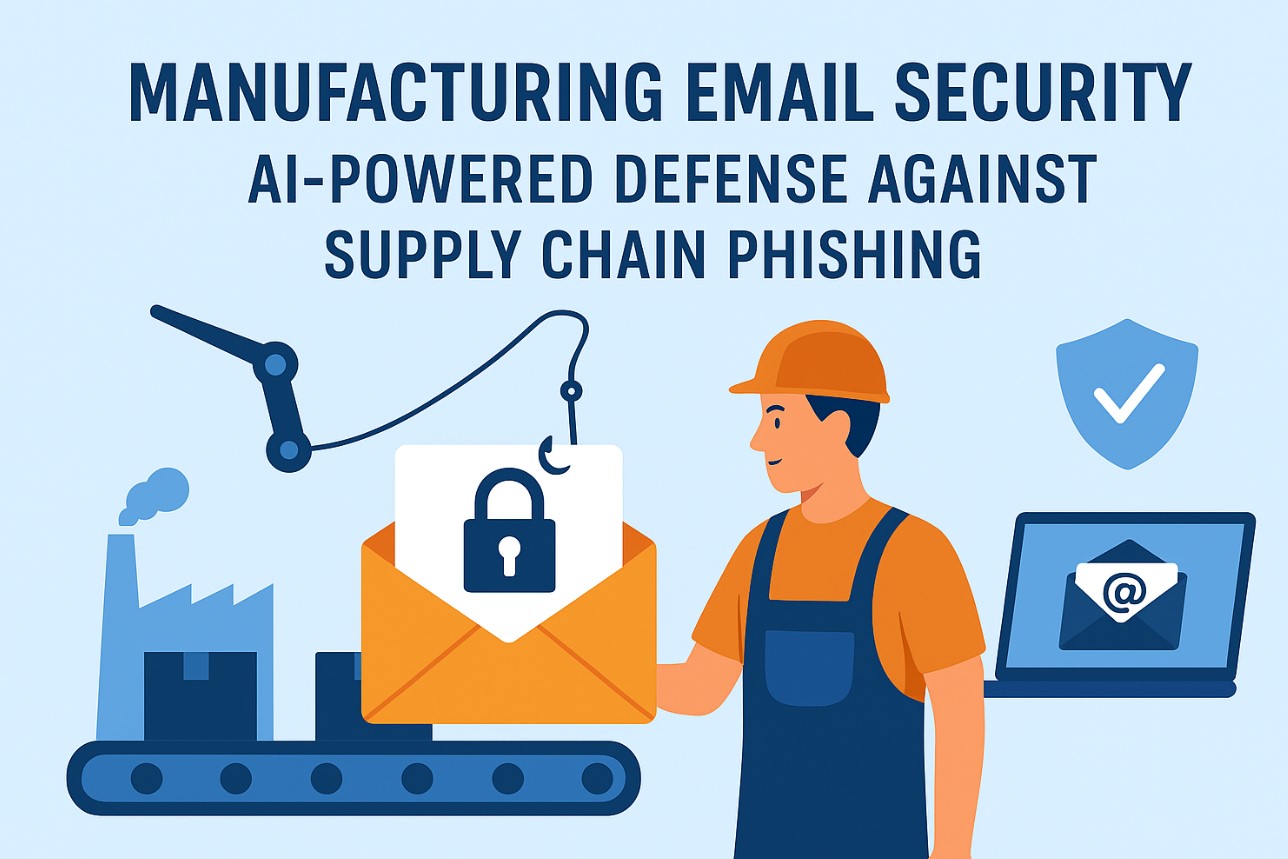
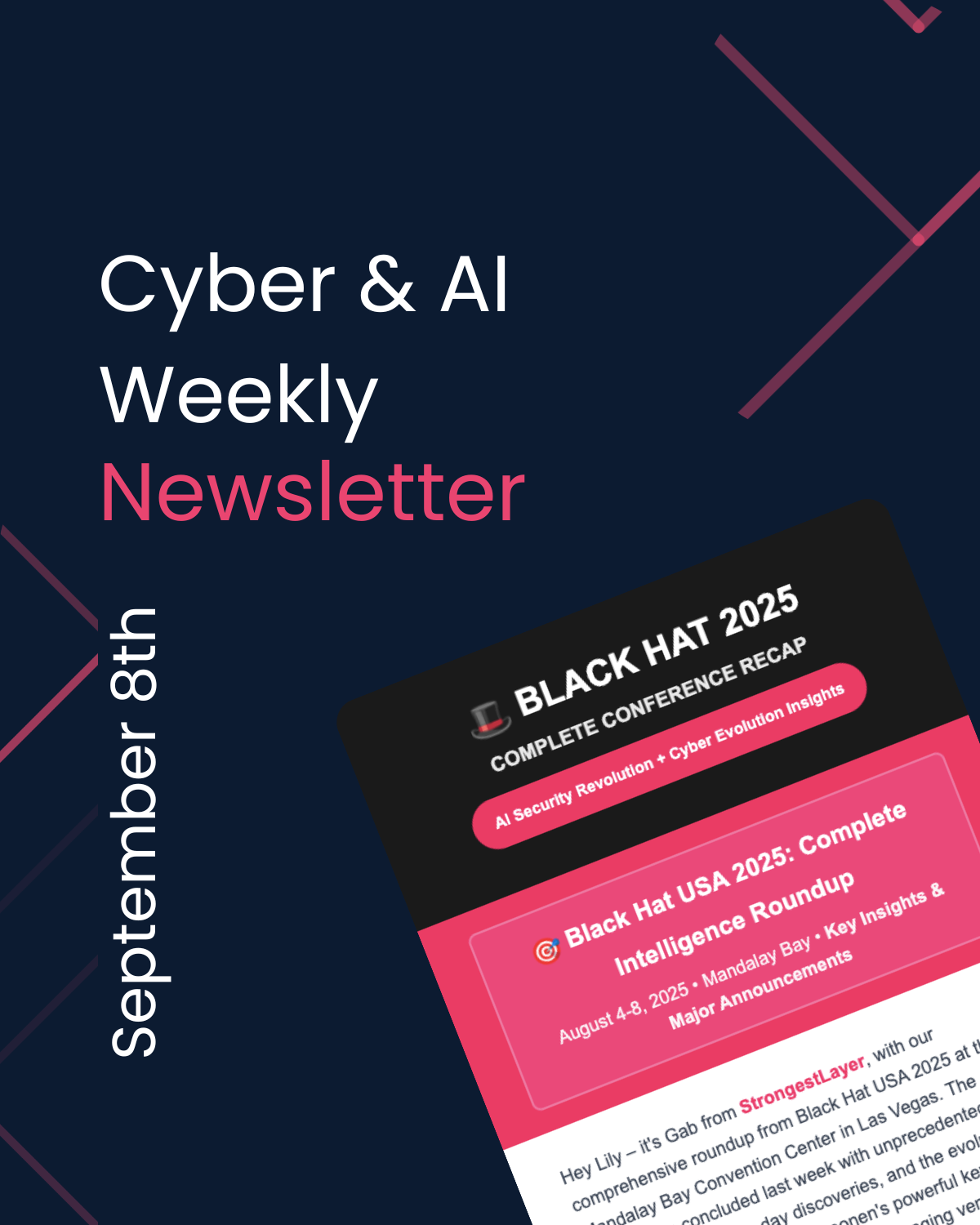


.png)

.png)


.png)
.jpg)
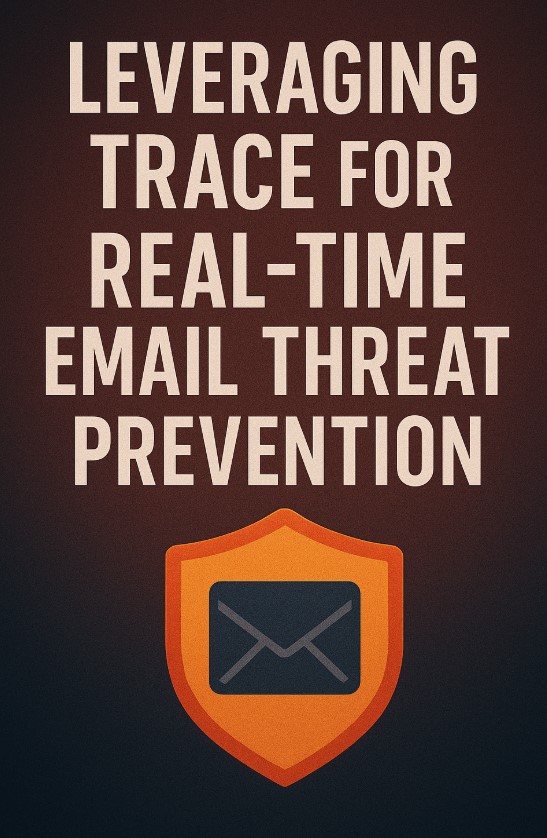
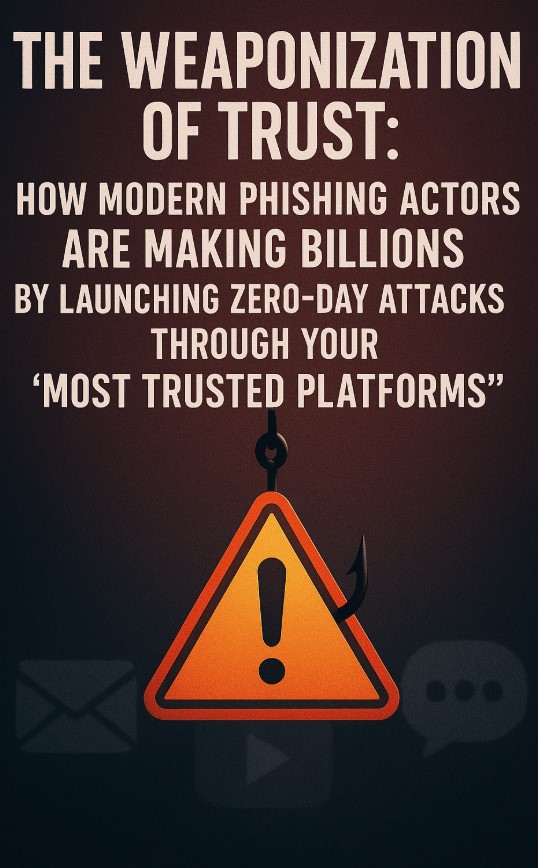


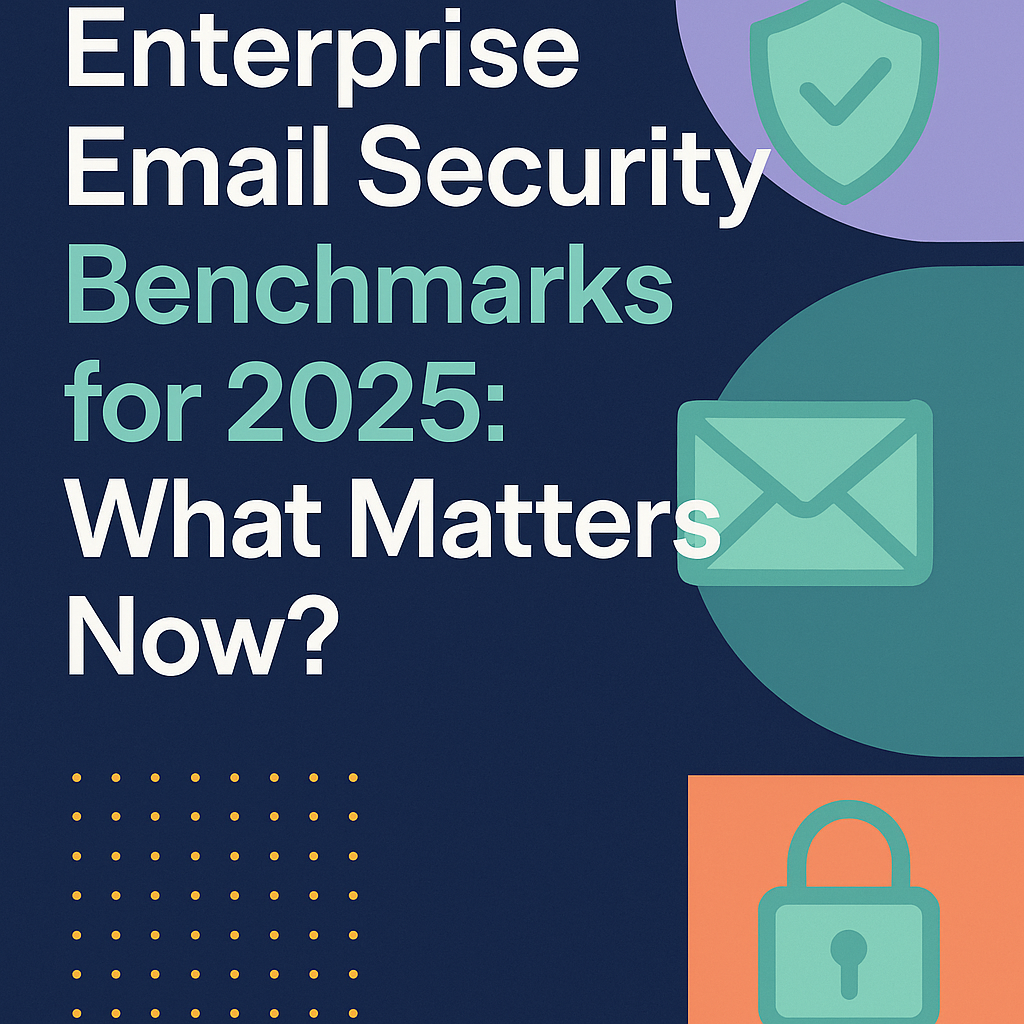
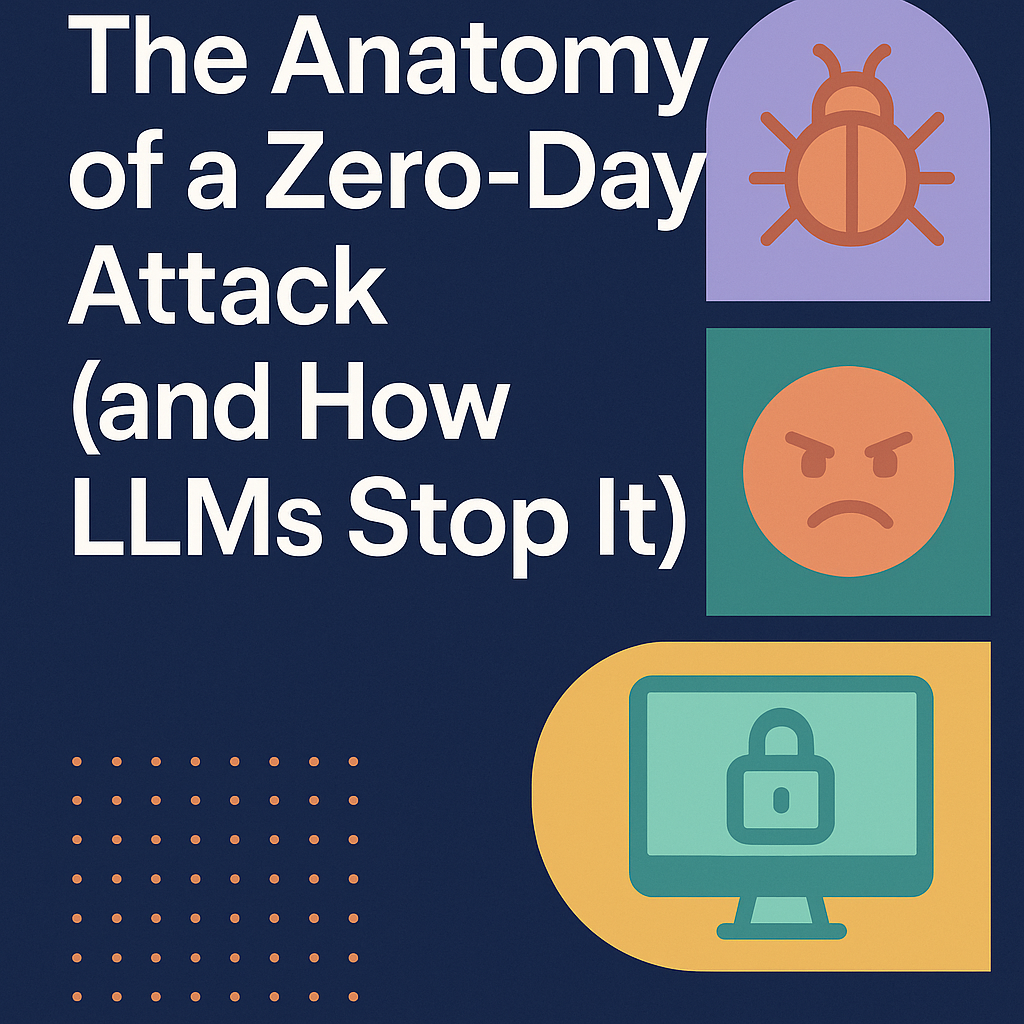

.png)







.png)































%20Attacks%20in%202025.jpg)









